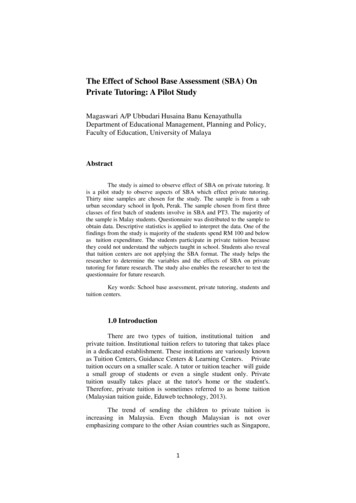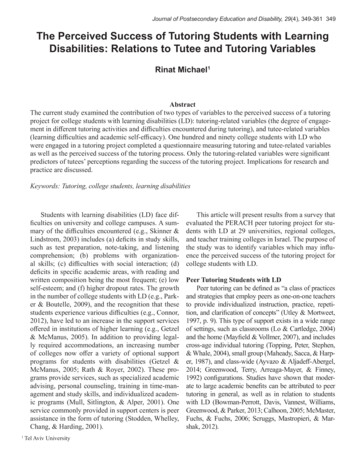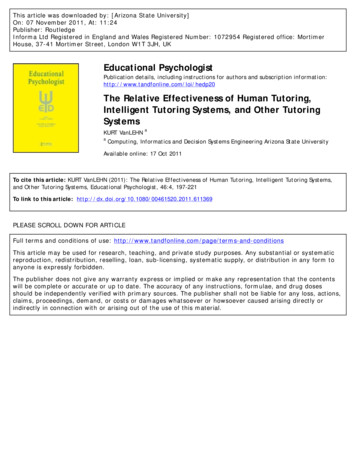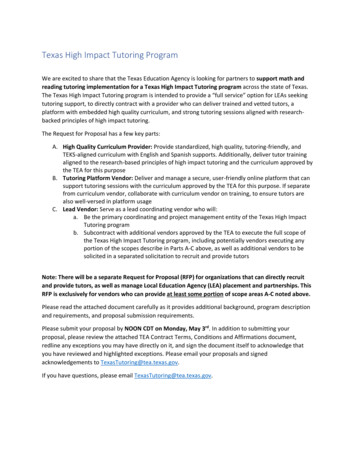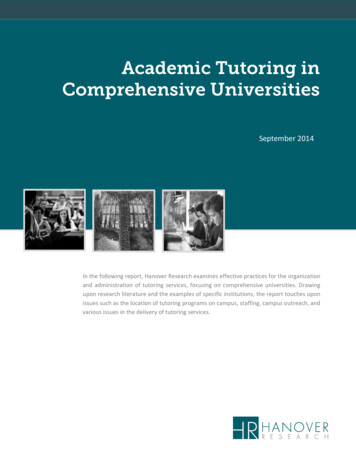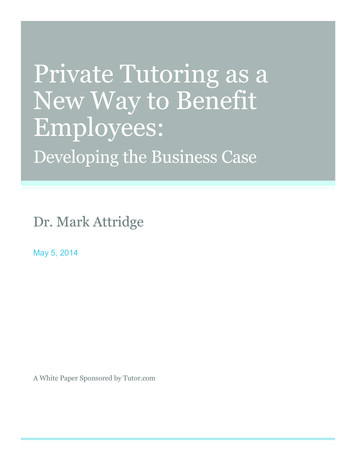
Transcription
Private Tutoring as aNew Way to BenefitEmployees:Developing the Business CaseDr. Mark AttridgeMay 5, 2014A White Paper Sponsored by Tutor.com
Private Tutoring as a New Way to Benefit Employees: Developing the Business CaseTable of ContentsExecutive Summary2PART 1 - Organizational Culture:How Private Tutoring Contributes to Organizational Success3PART 2 - History:An Overview of Private Tutoring7PART 3 - Technology:Advantages of Providing Private Tutoring via the Internet9PART 4 - Return On Investment:A Logic Model for Private Tutoring as An Employee Benefit11Conclusion13References14About the Author16Mark AttridgePage 1
Private Tutoring as a New Way to Benefit Employees: Developing the Business CaseEXECUTIVE SUMMARYThis report advances the idea of offering private online tutoring as a new kind of corporate benefit for employeesand their family members. Although a relatively small number of employers offer online tutoring as a benefit of workingfor their organization today, the research literature and available employer case studies provide a strong business casefor the practice.The largest early adopter in this area is the United States Department of Defense (DoD). In 2007, the DoD partneredwith Tutor.com to create an online tutoring and homework service to provide learning support to every child whose parentserves in the U.S. Military. In 2014, more than two million families in all branches of the military have access to the benefitof online tutoring as an employee benefit.This report reviews the evidence from applied social science and business trade publication sources on several topicsrelated to tutoring and employee benefits. The material is divided into the following four areas:Part 1: Organizational Culture The first part of the report addresses how tutoring can contribute to organizational success through making companiesmore attractive as places to work and through enhanced employee work performance related to reducing work-familystress. Part 2: HistoryThe second part provides an overview of the growth of private tutoring as a service and as an employee benefit.Part 3: Technology Next is a discussion of the how Internet technology has dramatically improved the access, effectiveness, quality andcost of delivering private tutoring online.Part 4: Return on Investment The final part of the paper introduces a logic model for estimating the financial return-on-investment or ROI foremployers who add online tutoring as an employee benefit.Mark AttridgePage 2
Private Tutoring as a New Way to Benefit Employees: Developing the Business CasePART 1 – ORGANIZATIONAL CULTURE: How Private Tutoring Contributes to Organizational SuccessHaving a reputation of being a good place to work (i.e., an employer of choice) can help to attract and retain goodemployees. Many companies also improve workforce performance and productivity by offering services that reduce stressand encourage a good work-life balance. These twin goals can be addressed by adding private tutoring as a new kind ofcompany-sponsored benefit for employees and their family members.1Private Tutoring as a New Form of Work-Family Benefit Some innovative companies now sponsor private tutoring for employees and their family members as a benefit ofworking for the company. This trend has been noted in industry press and as a benefit at some companies on the“best companies to work for” lists. In 2008, Futurethink CEO Lisa Bodell included child-tutoring programs as one of the features of the next generationof work-life benefits for working mothers in the U.S., along with pregnancy support, extra paid time off andsabbaticals.2 Also in 2008, Employee Benefit News reported that Intel started to offer online private tutoring for the children andgrandchildren of employees. According to David Kirby at Intel, the new benefit “ties to a broader strategy that we’vegot in flight right now, which is to really create an environment for employees where they perceive and believe thatIntel is a great place to work, and they get value from [working at Intel] other than just traditional compensation andbenefits”.3Private Tutoring as a Way to Attract and Retain Employee Talent Employers have long understood the value of having a positive public image or corporate reputation for enhancingrecruitment efforts to attract new employees.4,5,6,7,8 MetLife interviewed over 1,200 U.S. workers in 2013 about the role of benefits in employee recruitment and retention.9The study found that a large percentage of employees felt that benefits played a role in both recruitment and retention:43% of employees agreed that: “Benefits are an important reason why I came to work for my employer.” and50% of employees agreed that: “Benefits are an important reason I remain with my employer.”Companies Already Support Employee Education Although the idea of offering company-sponsored private tutoring assistance for family members as an employeebenefit is new to many organizations, the majority of large companies in the U.S. already provide financial support fortheir employees who pursue their own post-secondary education. Numerous surveys over the past 15 years have shown that at least two-thirds of large employers offer some form ofpaid tuition assistance to their employees who are taking college or university courses.10-13 Scholarships and in-kindeducational benefits are also provided. Companies consider education related benefits as contributing to employee development, recruitment andretention.14,15 By providing educational benefits, organizations demonstrate that they support the continueddevelopment and learning of their employees and their families.16 For example, one review concluded:“An organization that promotes opportunities to enhance current skills and develop new skills sends a messagethat it values a highly trained workforce and is committed to investing in its human capital.”17 Adding a private tutoring benefit for families of employees follows the same rationale for the company-sponsorshipof educational tuition support benefits, scholarships, and in-kind education albeit with a much smaller investment.The employees themselves can also use the tutoring service if they are taking college courses.Mark AttridgePage 3
Private Tutoring as a New Way to Benefit Employees: Developing the Business Case The financial outcomes from cultural factors that can accrue to the organization that offers tutoring are twofold: Firstare the operational efficiencies that come with being an employer of choice and of needing less time to recruitand hire desirable new employees; and secondly are the cost-savings in lower turnover rates for the existingemployees who use and value the tutoring benefit for themselves or for their family. See the ROI Section later in thispaper for more detail.Many of the “Best Companies to Work For” Offer Private Tutoring as a Benefit to Employees Companies that have achieved public recognition for being on the lists of “best places to work” include private tutoringas an employee benefit. Some of these companies are: Intel (one of the 2009 Working Mother 100 Best Companies) offers online private tutoring from Tutor.com.18 Johnson & Johnson (one of the 2013 Working Mother 100 Best Companies) offers high school junior andsenior students use of the company’s discounted homework and 24/7 tutoring service.19 Mass Mutual Financial Group (one of the 2013 Working Mother 100 Best Companies) offers older childrenfree homework tutoring and college coaching programs.20 MetLife (one of the 2013 Working Mother 100 Best Companies) offers parents and their children access tocollege test prep courses and tutoring at a 10% discount.21 Millennium: The Takeda Oncology Company (one of the 2013 Fortune 100 Best Companies to Work For)offers online private tutoring from Tutor.com.22 Northern Trust (one of the 2013 Working Mother 100 Best Companies) offers free homework tutoring,counseling sessions and college coaching through online private tutoring from Tutor.com.23 Northwestern Memorial Healthcare (one of the 2013 Working Mother 100 Best Companies) offers tutoring forchildren at the day care center located at the company’s headquarters office location.24 Sanofi-Aventis U.S. (one of the 2013 Working Mother 100 Best Companies) offers online tutoring and SATtest prep for children ages 4 to 18, which might help them score one of the available college scholarshipsprovided by the company, each worth 10,000. Tutoring provided by Tutor.com.25 Southern Ohio Medical Center (one of the 2014 Fortune 100 Best Companies to Work For) offers onlineprivate tutoring from Tutor.com.26 The Phoenix Companies (one of the 2013 Working Mother 100 Best Companies) offers tutoring as anemployee benefit.27 Verizon Wireless (one of the 2013 Working Mother 100 Best Companies) offers online private tutoring fromTutor.com.28Private Online Tutoring as a Way to Reduce Family Stress for Working Parents A second major reason for employers to offer a private tutoring benefit is to reduce the stress parents feel from theirchild’s daily school work and overall performance at school. Today, more than half of all children in the U.S. under age 18 live in households with two employed parents or oneemployed single parent.29 Consequently, most of these parents are at work when their children get out of school, oftengenerating parental concerns about their children’s welfare after school and being able to complete their homeworkwhen unsupervised.30 Many parents are often too busy working to help their children with school. Indeed, according tothe 2008 national survey by the Work and Families Institute, 75% of working parents reported not having enough timeto spend with their children.31Mark AttridgePage 4
Private Tutoring as a New Way to Benefit Employees: Developing the Business Case But private online tutoring can help overcome this time problem for families by offering 24/7 access to schoolsupport services. This on-demand model for usingtutoring services keeps parents’ focused at work duringthe day and also gives them more relaxed time in theevening with their family. In addition to the increased rate of workforce participationby working parents, other societal changes have occurredover the past few decades that make it harder to balancethe competing demands of work and family lives.32 Theseconflicting demands can sometimes have negative effectsat work, at home and for the individual with increased stressand health problems. Several studies and literature reviews of applied workplaceresearch confirm these linkages.33-38 For example, the authorsof a 2014 review study stated:“Americans find themselves caught between twoinconsistent social ideals: the ideal worker norm, whichenshrines the employee ever-available for paid work,and the norm of intensive parenting, which enshrines theparent who is ever-available for their children.”39 There are many examples of how family experiencessometimes interfere with job performance. An early studyfound that 53% of respondents reported that worryingabout their children had caused them to waste time andmake mistakes at work.40 In a sample of employees from20 different Fortune 500 companies, 28% of men and 53% ofwomen reported that work-family stress affected their ability toconcentrate at work.41 Finally, a 2006 study of parents employed at a major globalfinancial services company, found that parental concern aboutafter-school time was related to job disruptions in both levelof distraction at work (i.e., productivity) and in missed days ofwork.42 To avoid these problems, many organizations have enactedcorporate policies and employee benefit programs aimedat providing employees with resources to help them bettermanage their personal and family lives. Grover and Crookerfound that employees who had family responsive benefits(e.g., flexible schedules, child-care information services) weremore committed to their organization and were less likelyto think about looking for a new job, regardless of whetherthey actually used the benefit.43 In general, according to onereview: “Most studies find that innovative human resourcemanagement (HRM) practices have a positive impact on firmlevel outcomes.”44Mark Attridge“I used to work all day and when Iwalked in the door, the girls wouldbe wailing ‘Help me, Mommy!I don’t know what to do!’ Theirhomework made life so stressful,and I would get stuck on a mathproblem and not be able to helpthe girls figure out the answer.Sometimes I’d stress about it allnight and wake up thinking aboutthe problem! I think of Tutor.comas stress relief!”– private interview with Lucy, a working mom Working Parents and HomeworkThe National Center for FamilyLiteracy partnered with Google inAugust of 2013 to conduct an onlinesurvey of 137 parents with studentsin grades 1 through 12 about theparents’ ability to help with theirchildren’s homework. Key findingsfrom this study indicated that: 49% ofparents struggle with providing kidsthe homework help they need; 47%of parents feel they themselves don’tunderstand the subject matter of thecoursework for their children; and 1in 5 parents are often “too busy” withwork and activities of their daily livesto spend time reviewing their child’shomework.Page 5
Private Tutoring as a New Way to Benefit Employees: Developing the Business Case A Watson Wyatt survey of employers in the U.S. foundthat 77% of respondents believed that work-life programsimprove employee satisfaction; and 54% believe that theyenhance employee health and productivity.45 In an interview with Employee Benefit News, a manager for a company offering tutoring as part of the work/lifebenefits, commented: “Productivity increases whenparents are not preoccupied worrying about their children’sneeds. Additionally, the [tutoring service] helps demonstrateemployers’ efforts to support education.”46 The work-life services vendor Care.com has the followinguser self-reported survey results: 92% of employees reportthey are better able to focus at work with their family’scare needs met; 91% feel more positively regardingtheir employer; and 60% have been able to improvetheir focus and work more hours. This data is for usersof search and referral services of children, adults/seniorscare, pets, and home and lifestyle.47 Thus, the business case for offering educational supportand tutoring for employees and their family members issimilar to the arguments for offering work-life programs and employee assistance programs. But whereas the usersof work-life and EAP services are most often the employees themselves, tutoring as a benefit extends to bothemployee and family members. Adding online private tutoring as a new kind of benefit potentially adds value to bothemployers and employees.Mark AttridgePage 6
Private Tutoring as a New Way to Benefit Employees: Developing the Business CasePART 2 – HISTORY: An Overview of Private TutoringPrivate Tutoring Defined What is tutoring? Private tutoring is defined as fee-based tutoring that provides supplementary instruction on a oneto-one basis to children in academic subjects they study in the mainstream education system.48 What is not tutoring? The first line in the National Tutoring Association’s ethics code is: “I understand that my role asa tutor is to never do the student’s work for him or her.”49 Why do students use tutoring? Private tutoring has two main roles: First, high-achieving students tend to use itto better prepare for getting into the next level of school or into college (enhancement or enrichment); and second,low-achieving students tend to use private tutoring for help in satisfying basic academic requirements (remedialeducation).50 Thus, students may seek tutoring for either high achievement or remedial purposes. Tutoring can also help to reduce psychological factors associated with learning and academic development, such asanxiety over test taking and grades.51 When is tutoring most relevant? Tutoring is especially appropriate for students who are at the transition pointsleading to the next stage of education, such as before the end of primary, lower secondary and upper secondaryschooling. Tutoring in the difficult subjects of math, science, and writing for all subjects can remove stumbling blocks. Algebrais, for instance, known as the gateway course for success in high school, which often determines the trajectory forcollege. At Tutor.com, algebra is the number one most requested subject for tutoring support. High school studentsalso work with tutors for help with a variety of advanced placement subjects (AP courses) as part of their preparationfor college. Tutoring is also used to prepare for taking qualifying national standardized exams, such as the SAT, whichare required to apply to get into many colleges and universities. Do adults use private tutoring? Tutoring is not just foryounger children and high school students. In the U.S.,private tutoring is offered at over 70% of both 2-year and4-year institutions of higher education.52 In 2009, the U.S.Department of Education found that over one-third of collegefreshman took a remedial or developmental course.53Thus, college students can also benefit from tutoring tohelp stay in college during the challenging freshman orsophomore years. Effective Tutoring Requires Experienced TutorsTutoring is especially appropriatefor students who are at thetransition points leading to the nextstage of education, such as beforethe end of primary, lower secondaryand upper secondary schooling. Research studies provide general support for the effectiveness of one-on-one personalized educationalintervention for students over the more traditional classroom settings.54,55 The effectiveness of tutoring wasestablished over 20 years ago in a comparative meta-analysis of 65 studies of tutoring in various subject areas.In 86% of these studies, tutored students achieved higher scores than those in the control group.56 However, nonprofessional tutors – such as volunteers, parents, and student peers – require training in order to be effective.57-59 A substantial body of research has demonstrated that parents can be effective tutors and help their younger childrenmake gains in reading skills.60,61 However, as children get older and into more advanced academic subjects manyparents are not qualified to serve as tutors considering that the instructional methods have changed since they were inschool. This is especially true for the parents of children taking college preparatory classes.Mark AttridgePage 7
Private Tutoring as a New Way to Benefit Employees: Developing the Business Case Global Growth in Private Tutoring Services Private tutoring now has grown to have global significance.62 In many countries, private tutoring has arisen as aparallel education sector that provides supplementary instruction to students enrolled in the public school system.Substantial private tutoring industries can be found in countries as economically and geographically diverse asCambodia, the Arab Republic of Egypt, India, Japan, Kenya, Morocco, Romania, Singapore, the United Kingdom, andthe United States. According to Bray, private tutoring is a huge industry in much of Asia and is growing fast in Africa,Europe and North America.63 Researchers from Canada suggest that, “for an increasing number of families, tutoring has become a corecompetitive strategy.”64 For example, about 1 in 4 of Ontario parents with school-age children have hired privatetutors,65 and half of all Canadian parents claim they would hire a tutor if it were more affordable.66 Cost of Private Tutoring to Parents The cost of private tutors can be high if paid directly by the parents. In 2010, Sullivan noted “reasonable” rates of 85to 150 or more per hour in New York City, with some having rates of over 250 per hour.67 The rate in other parts ofthe country is lower than in the largest cities. According to a 2012 article in Money magazine, parents in the U.S. canexpect to pay from 80 to 100 per hour for one-on-one tutoring.68Mark AttridgePage 8
Private Tutoring as a New Way to Benefit Employees: Developing the Business CasePART 3 – TECHNOLOGY: Advantages of Providing Private Tutoring via the InternetAdvances in communication technology have made high-quality tutoring more widely available. Telephone tutoring is oneoption, but it has increasingly been supplemented or displaced by Internet tutoring.69,70 When using this online format,tutors can be as flexible in their instruction as with face-to-face instruction, including their use of materials; online tutorscan use text chat, white boards, shared websites, voice over IP, as well as print materials and more.71How Online Tutoring Works Unlike face-to-face tutoring, which puts heavy scheduling and transportation burdens on students and their parents,online tutoring services allow students to meet with a tutor anytime, from any computer, and without even needing tomake an appointment.72 The spontaneous and voluntary nature of online tutoring means that students are ableto get help the moment they need it, before frustration sets in that causes many students to abandon the problem. A student typically works with a tutor for only 20 to 30 minutes and uses that time to focus on a specific problem orissue on which the student has been working. These tutoring sessions are conducted in an “online classroom” wherestudents and tutors work through problems using an instant-messenger-like text chat and a shared whiteboard. Themost advanced online classrooms offer features like multiple whiteboards, graphing tools and the ability to share filesand web pages back and forth. It is also possible to record the entire session so students, parents and teachers canreview the session at any time. The positive practical implications for parents are alsoimportant. First, tutoring services can be convenientlyaccessed from any home with adequate technology aswell as most mobile devices. With traditional face-to-facetutoring, parents often have to take their students to whereverthe tutor is located and may have to wait or return later topick up their children to take them home. Online tutoring that is offered 24/7 may reduce schedulingconflicts as the family is in control of when the tutorinhappens. Synchronous online tutoring offers a valuablereduction in both time and transportation costs.The easy access to online tutoringhas made tutoring more convenientand a child can log on to theInternet and connect to a tutoranytime for a brief help sessionthat can prevent them from fallingbehind in homework. In addition, even when parents do find the time, because of the effort involved with finding a tutor and the challengelogistics of arranging multiple in-person meetings, as well as the cost, parents have traditionally used private tutoringonly for crisis situations such as when their son or daughter has fallen far behind in school and brought home a nearfailing or failing grade. The easy access to online tutoring has made tutoring more convenient and a child can logon to the Internet and connect to a tutor anytime for a brief help session that can prevent them from falling behind inhomework.Research on the Effectiveness of Online Tutoring A 2004 meta-analysis study examined interactive K-to-12 distance education technologies featuring videoconferencingand telecommunications compared to education delivered in face-to-face classroom settings.73 In 19 studies withover 900 total participants, the study results indicated very similar findings for the two methods. The authors thereforeconcluded that students experienced similar levels of academic success whether the courses had usedtechnology-based teaching methods or traditional classroom settings. This research provides evidence for thesuccess of online tutoring.Mark AttridgePage 9
Private Tutoring as a New Way to Benefit Employees: Developing the Business Case Online tutoring is effective for students of different ages. Online tutoring was found to be effective for improving thereading skills of 4th grade students.74 Another study focused on the efficacy of online tutoring in higher educationsettings and found that college students had improved content knowledge and many of the students even preferredthe virtual tutoring over face-to-face classroom interactions.75Online Technology Improves Tutoring Quality and Reduces Cost One of the reasons for the effectiveness of online tutoring is that the technology involved drives up quality andtransparency of the services while driving down the price to deliver the services. Traditional private tutoring that is conducted face-to-face is often very expensive because of a mismatch of the supplyand demand for the tutors. The pool of experts who live in any given community who can tutor in person is quitelimited. Meanwhile, there are many well-qualified tutors who live in rural college towns. A large well-managed onlinetutoring service brings these two populations together via the Internet in a mutually beneficial way. Also, it is extremely difficult to gauge the quality of an in-person tutor. Not so with online tutoring where every sessionis recorded, the transcript of the tutoring session is reviewed, and anonymous feedback is solicited from every studentserved. This is part of what leads to very high levels of student-rated satisfaction ratings for online tutoring.Student-rated Effectiveness of Online Private Tutoring at Tutor.com The data from millions of surveys collected after the end of online tutoring sessions from the student users ofTutor.com have revealed very positive results. Recent data from student users at corporate benefit clients shows that: 96% say the service helps them be more confident about their school work 95% say the service helps them improve their grades 97% say the service helps them complete their homework assignments 97% would recommend this service to a friend 98% are glad the company offers this serviceExample of Online Tutoring User Experience:Whenever Peggy Bennett of Dallas tried to help her 13-year-old daughter, Chloe Friedman, with her eighth-grade physics and algebra homework, “we’d always end up bickering,” Ms. Bennett says, with Chloeoften objecting that the teacher did it differently. “It was a lose-lose situation.” Chloe says she was skepticalwhen her mom helped her sign up last month on Tutor.com, a New York City-based provider of on-demandtutoring. But after she logged on one evening for algebra help, a tutor, identified only by a first name and lastinitial, responded within a minute. Chloe says she was guided to figure out the answers, using text chat andan interactive “whiteboard” that displayed their writing and calculations on a shared screen. After hearingnothing but typing for about 10 minutes, Ms. Bennett says she heard Chloe yell from the other room,“They told me I did a good job!” Ms. Bennett adds, “That was all that she needed.”From The Wall Street Journal, 2013.76Mark AttridgePage 10
Private Tutoring as a New Way to Benefit Employees: Developing the Business CasePART 4 – RETURN ON INVESTMENT: A Logic Model for Private Tutoring as an Employee BenefitMany organizations invest in their workforce in a variety of ways often with a variety of motivations and justifications forthe benefits budget. To add online tutoring services as a benefit that is pre-paid by the employer does involve a cost tothe sponsoring organization – but this cost is much less than for most other contemporary work-life and EAP typeservices. To offset this cost of providing tutoring benefits are positive financial outcomes that can provide a significantreturn on investment (ROI). Even having very small effect sizes and conservative estimates of the dollar value for eachoutcome effect area can add up to a substantial amount of total savings associated with having private tutoring as abenefit for employees.More specifically, the financial value to the organization from sponsoring the online private tutoring benefit comes fromthree outcomes at different phases of the employee life-cycle: among new employees in deciding to come to work for theorganization; better work performance among current employees; and keeping employees from leaving.Area I: Recruitment T he first area of ROI value and savings from having a tutoring benefit is the more rapid time to hireemployees. This outcome is measured in lower recruitment and hiring costs for the new employees whoare more attracted to join the organization because it offers private tutoring as a benefit of employment. Theevidence for this outcome in the research literature supports early-adopters and “best practice” companies thatsponsor tutoring as a benefit (see Part 1 of this paper). Attraction to a family-friendly organizational culture isalso a regularly occurring theme found among the comments voluntarily provided by the individual employeeswhose family members have used tutoring services.Area II: Workforce Performance T he second area of ROI value and savings from having a private tutoring benefit for employees is betterworkforce performance among the employees who use the service due to then having lower levels ofschool-related absenteeism and presenteeism. These outcomes are generated by two kinds of employees: a) working parents of children who use the tutoringbenefit and thus experience less work-family conflict for supporting their children’s school and homeworkneeds; and b) employees who are in college part-time while working at the organization who use the tutoringbenefit themselves to better manage their course demands and their work duties.Area III: Retention Being considered a great place to work is not onlygood for getting higher quality employees to join anorganization; it is also good for keeping them fromleaving. Greater employee loyalty can be fosteredby offering highly valued benefits that can becustomized to the needs of the employee, such asthe priva
How Private Tutoring Contributes to Organizational Success 3 PART 2 - History: An Overview of Private Tutoring 7 PART 3 - Technology: Advantages of Providing Private Tutoring via the Internet 9 PART 4 - Return On Investment: A Logic Model for Private Tutoring as An Employee Benefit 11 Conclusion 13 References14 About the Author 16
